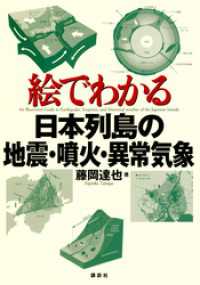- ホーム
- > 洋書
- > 英文書
- > Science / Mathematics
Full Description
This book provides a general survey of Geocryology, which is the study of frozen ground called permafrost. Frozen ground is the product of cold climates as well as a variety of environmental factors. Its major characteristic is the accumulation of large quantities of ice which may exceed 90% by volume. Soil water changing to ice results in ground heaving, while thawing of this ice produces ground subsidence often accompanied by soil flowage. Permafrost is very susceptible to changes in weather and climate as well as to changes in the microenvironment. Cold weather produces contraction of the ground, resulting in cracking of the soil as well as breakup of concrete, rock, etc. Thus permafrost regions have unique landforms and processes not found in warmer lands.
The book is divided into three parts. Part 1 provides an introduction to the characteristics of permafrost. Four chapters deal with its definition and characteristics, the unique processes operating there, the factors affecting it, and its general distribution. Part 2 consists of seven chapters describing the characteristic landforms unique to these areas and the processes involved in their formation. Part 3 discusses the special problems encountered by engineers in construction projects including settlements, roads and railways, the oil and gas industry, mining, and the agricultural and forest industries.
The three authors represent three countries and three language groups, and together have over 120 years of experience of working in permafrost areas throughout the world. The book contains over 300 illustrations and photographs, and includes an extensive bibliography in order to introduce the interested reader to the large current literature.
Finalist of the 2019 PROSE Awards.
Contents
Introduction and characteristics of permafrost. Definition and description. Cryogenic processes where temperatures dip below 0˚C. Factors affecting permafrost distribution. Distribution of permafrost. Permafrost landforms. Frost cracking, ice-wedges, sand, loess and rock tessellons. Massive ice in lowlands. Permafrost mounds. Mass wasting of granular and fine-grained materials in cold climates. Mass wasting of blocky materials in colder climates. Cryogenic patterned ground. Thermokarst and thermal erosion. Use of permafrost areas. The mechanics of frozen soil. Foundations in permafrost regions: Building stability. Roads, Railway and Airfields. Oil and Gas industry. Mining in permafrost areas. Provision of utilities. Agriculture and forestry. References. Index.
-

- 電子書籍
- アクアマン【タテヨミ】第41話 決断(…
-

- 電子書籍
- げんきの絵本 ひょうしきと マークずかん
-

- 電子書籍
- 私立校・中高一貫校生 二学期から始める…
-

- 電子書籍
- 絵でわかる日本列島の地震・噴火・異常気…



